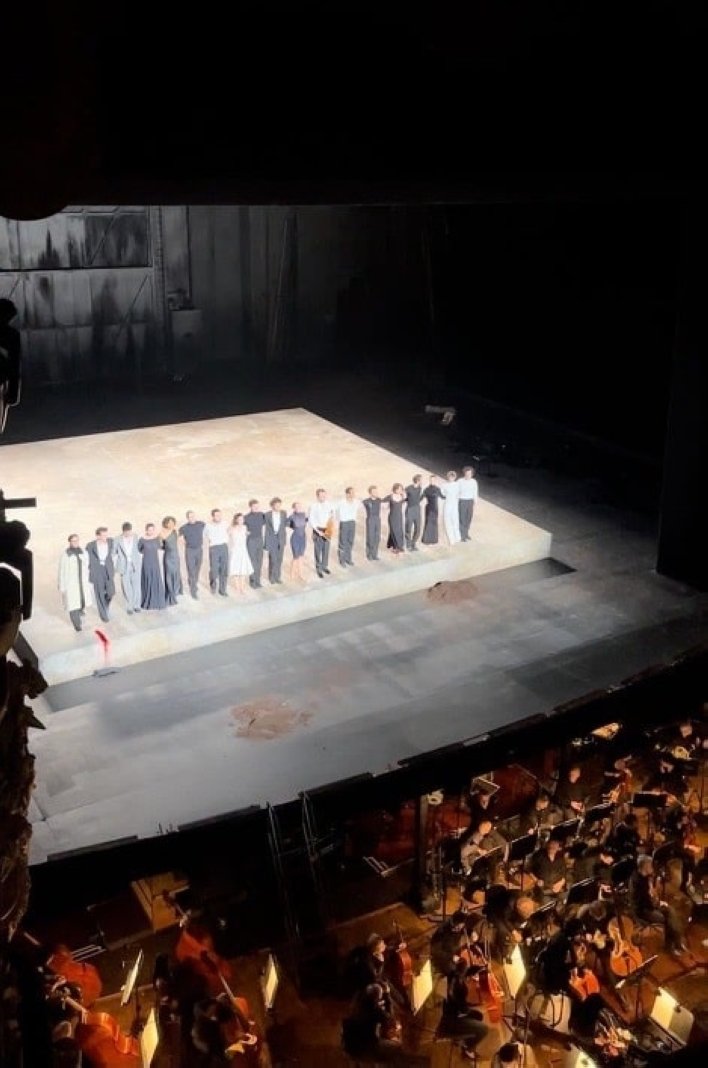© Turkuvaz Haberleşme ve Yayıncılık 2024
Once again, the Paris Opera has chosen to entrust the creation of a new piece to two foreign choreographers with no prior connection to the institution.
Bobbi Jene Smith and Or Schraiber, acclaimed for their work with the Israeli company Batsheva but relatively unknown in France, aside from a performance at the Theatre du Chatelet in October 2022, have surprised audiences with their debut at the Palais Garnier in Paris. Their creation, "Pit," features exquisite costumes by Alaia and is masterfully danced by 19 members of the Paris National Opera. The piece has garnered praise for its unique and daring take on contemporary dance, with many noting the hauntingly beautiful score, which combines Jean Sibelius' "Violin Concerto" with Celeste Oram's sonic artistry.
"Pit" is an ode to the experience of human life, conceived in harmony with the music. Bobbi Jene Smith has referred to Sibelius' concerto as "the seed (pit), the core of a dark fruit," which inspired the name of the piece.
The Palais Garnier's stage is open and diffusely lit from the top, creating an atmosphere more reminiscent of an abandoned palace or cathedral than a traditional theater space. The raised platform on the stage follows the slope of the theater, performing an added dimension.
As the curtain rises, the orchestra, conducted by Joana Carneiro, plays a piece composed by Celeste Oram for the choreography. The set is minimalistic, consisting only of the wall of the auditorium. The dancers, elegantly attired, are initially seated in one corner before gracefully taking the stage in a ballet of black and white costumes.
Each detail, costume and movement create its unique world, with the white fur worn high on the thighs serving as "Pit's" fashionable and chic aesthetic. The piece transports the audience into a social gathering where couples exchange pleasantries, embrace each other with the desperation of a life preserver, or throw themselves into each other's arms with unbridled passion. Evening gowns and wild glamour were pioneered by Pina Bausch (1940-2009), making it challenging to incorporate them into contemporary dance without risking an outdated aesthetic.
In the beginning, the raised stage appears to lack energy for the dancers. Only one couple gets up to dance, and gradually the rest of the group follows suit. However, they remain scattered and never form a cohesive group. Sometimes only a few of them go on stage, while others run back and forth downstairs in an endless cycle. There is always someone to catch or hold them back.
The violin soloist, Petteri Iivonen, is an integral part of the show. He enters the stage and takes out his violin, and suddenly the initial murmurs of the concert can be heard. One of the dancers, wearing a beige coat and glasses, seems to be observing the ensemble with a meditative and slightly disapproving attitude.
Throughout the performance, the dancers perform many solos but never form a group. Occasionally, about ten of them synchronize for a few minutes when the orchestral part takes over. Their movements are precise and determined as if they are purely performers. Sometimes, a dancer will start running and fall off the stage, only to be caught by another dancer. The solos and duets are both sensual and painful. The body expresses itself without saying anything.
A strong sense of authority permeates the piece, and the dancers are subject to it. They try to escape it through fused relationships or desperate flight. They move around on all fours, hiding from the authority. Later on, they are all desperately searching for land, which they present to a judge who sweeps it off the table and drops it on the bodies of two dancers lying almost motionless on the floor.
There are many magical moments in the performance, such as when Loup Marcault-Derouard launches into an angular and spasmodic solo, Marion Gautier de Charnace appears to improvise an expressionist dance, or Caroline Osmont offers herself in a red dress with symbolist flights and takes a surprising step back. The magnificent interludes run throughout the performance, which favors invisible movements or offstage over the luminosity of the dance. This ballet lacks a clear storyline but makes excursions into the world of images or symbols, only to force upon us the violent vision of a body covered in earth and to mask the messiness of the subject matter.

"Pit" is a passionate choreography that breaks down the group. The ensemble is also the authority, testing the bodies with passion as they devour and strangle each other. There is no progression, only an exploration of the liminal moment when the other is hated and separation is unthinkable. In the final minutes, blood flows over the edge of the stage, and one of the dancers wipes it up with a handkerchief.
Bobbi Jene Smith and Or Schraiber's world is a pit. The word "pit" means "gap" and also speaks of opposition, but the two choreographers strive to dissolve the confrontation between the stage and the audience. Despite the dark world they create, it remains closed in on itself.
